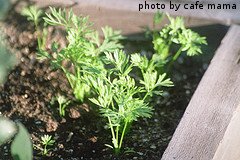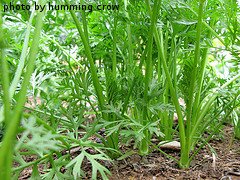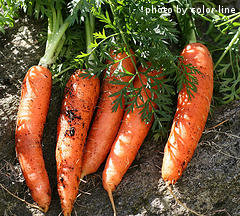Fertilizing and Watering Carrots
Watering Carrots
About a week after planting the seeds, you should start thinking about watering carrots. Carrots require about an inch of water per week to reach their full potential. If no rain falls in your area, you'll need to water the carrots yourself. A slow, deep soak is the best method. You can use a soaker hose or a drip irrigation system, but these options can be expensive. A mist from a garden hose sprayer will do the job just fine.

Before watering carrots, use your hands and dig down about 4 inches into the soil beside the plants. Take a handful of soil and squeeze it in your palm. You want the soil to hold together for a few seconds before crumbling apart. This is evidence that the soil is moist enough. If the soil is soggy and never crumbles apart, you should wait a few days to let it dry out and check again. If the soil doesn't hold together at all when squeezed, it's too dry and you need to water.
It's fine if the foliage gets wet when you water. Just make sure to water slowly enough so that no soil is eroded away. You want to water carrots deeply enough so that the bottom of the root gets plenty of water. Imagine that a growing carrot might be 6 inches under the surface of the soil. If the bottom of the carrot doesn't get enough water, it will likely end up deformed or fail to reach its full size
potential. For this reason, it's best to give carrots one long soak per week, rather than multiple shallow water sessions per week.
It's a good idea to water carrots in the early morning hours. This will allow any unused water to be evaporated by the afternoon sun.
After the tops of the carrots emerge, you can apply a thin layer of mulch around the plants. Grass clippings, chopped up leaves or straw all work well for mulch. This mulch will prevent too much water from being evaporated from the soil. As the carrot tops get taller, more mulch can be applied.
Fertilizing Carrots
If the soil in your garden is not rich in nutrients, you may need to fertilize your carrots. Carrots should be fertilized when the tops have reached 3 inches tall. A granular type fertilizer will work well, if used in moderation. Choose a fertilizer that has little nitrogen and more potassium and phosphate - 0-10-10 or 5-15-15 will work well. Pay attention to the 3 number code on the bag of fertilizer. These three numbers indicate the amount of nitrogen, phosphate and potassium that are contained in that particular fertilizer, respectively. For instance, a 10-10-10 fertilizer contains 10% nitrogen, 10% phosphate and 10% potassium. A 5-10-10 bag would contain 5%
nitrogen, 10% phosphate and 10% potassium. Nitrogen encourages a plant to produce more foliage. Phosphate and potassium encourages more root development. Because carrots are a root vegetable that grow below the surface of the soil, phosphate and potassium are more beneficial to carrot growth.

Apply the fertilizer at half the rate suggested by the manufacturer. If the directions call for 1 1/2 pounds for every 100 square feet, use 1/2 to 3/4 pound. Too much fertilizer will result in less flavorful carrots with forked and hairy roots. This is especially true if you also add fertilizer to the soil before you even plant. Once you have applied the granular fertilizer, water it in well.
Most of the time, water soluble fertilizers (the kind that are mixed with water and then sprayed onto the
plants) contain too much nitrogen and should not be used. If you want to grow carrots organically, work plenty of compost into the soil prior to planting. You can also apply a side dressing of fish emulsions, blood meal and/or bone meal to add nutrients to the soil.
In our own garden, we typically add a balanced granular fertilizer to the soil about a week before we plant our carrot seeds. We get the soil tilled good and deep. We scatter the fertilizer in at a rate of 1/2 pint per 100 square feet. We also scatter pulverized lime over the area as our soil is a bit acidic and lacking calcium. Then we till the fertilizer and lime into the soil and then water it in. About a week later, we till one more time and then use a shovel to create our raised rows and plant our carrot seed.
Now that you know all about fertilizing and watering carrots, it's time to think about harvesting your crop.

Click here to learn about harvesting carrots
Click here for some carrot recipe ideas
Click here to move from our Fertilizing and Watering Carrots page to the Growing Carrots main page
Click here to return to the Home page